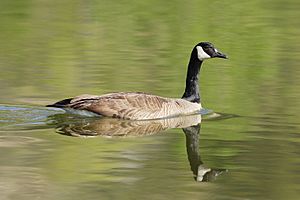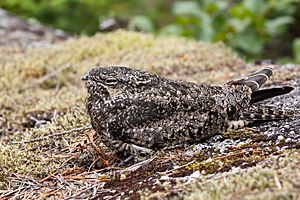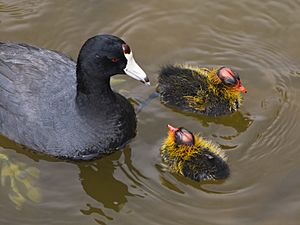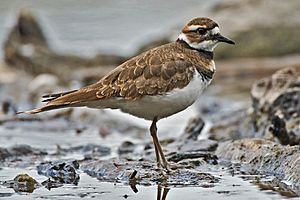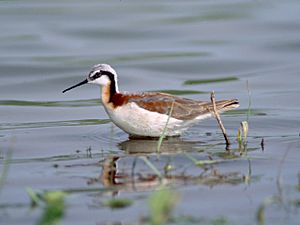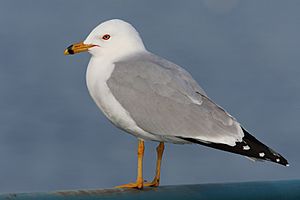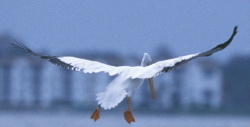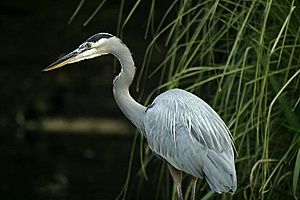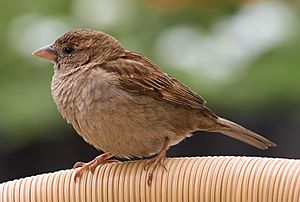List of birds of Isle Royale National Park facts for kids
This article lists the different kinds of birds found in Isle Royale National Park. This park is on an island in Lake Superior. Even though it's part of Michigan, it's actually closer to Ontario, Canada. This list mostly comes from the National Park Service (NPS).
The birds are listed in a special order called taxonomic sequence. This order is used by the American Ornithological Society (AOS) in their official bird checklist. The names of the birds (like "Canada goose") and their scientific names (like Branta canadensis) also come from this list. The names for bird families (like "Ducks, geese, and waterfowl") come from the Clements taxonomy.
This list has 256 different bird species. Most of these birds are regularly seen in Isle Royale National Park. Some live there all year, some visit in summer or winter, and others just pass through during migration. For birds that are less common, special tags are used to show how often they are seen:
- (R) Rare: These birds are usually seen only a few times each year (34 species).
- (U) Uncommon: You might see these birds monthly in the right places and seasons (75 species).
- (O) Occasional: These birds show up in the park at least once every few years, but not necessarily every year (68 species).
- (H) Historical: These birds are not currently in the park, but there are old records of them (1 species).
- (Unc) Unconfirmed: There's not much proof these birds are in the park (11 species).
- (PP) Probably present: We're pretty sure these birds are in the park, but we need more recent proof (3 species).
- (Unk) Unknown: We don't know how often these birds are seen (12 species).
- (I) Introduced: These birds were brought to North America by people (4 species).
Contents
- Ducks, Geese, and Waterfowl
- Grebes
- Pigeons and Doves
- Cuckoos
- Nightjars and Allies
- Swifts
- Hummingbirds
- Rails, Gallinules, and Coots
- Cranes
- Plovers and Lapwings
- Sandpipers and Allies
- Skuas and Jaegers
- Gulls, Terns, and Skimmers
- Loons
- Cormorants and Shags
- Pelicans
- Herons, Egrets, and Bitterns
- New World Vultures
- Osprey
- Hawks, Eagles, and Kites
- Owls
- Kingfishers
- Woodpeckers
- Falcons and Caracaras
- Tyrant Flycatchers
- Vireos, Shrike-babblers, and Erpornis
- Shrikes
- Crows, Jays, and Magpies
- Tits, Chickadees, and Titmice
- Larks
- Swallows
- Kinglets
- Waxwings
- Nuthatches
- Treecreepers
- Wrens
- Mockingbirds and Thrashers
- Starlings
- Thrushes and Allies
- Old World Sparrows
- Wagtails and Pipits
- Finches, Euphonias, and Allies
- Longspurs and Snow Buntings
- New World Sparrows
- Yellow-breasted Chat
- Troupials and Allies
- New World Warblers
- Cardinals and Allies
- See also
Ducks, Geese, and Waterfowl
Order: Anseriformes Family: Anatidae
This family includes ducks, geese, and swans. These birds are great in water! They have webbed feet and special feathers that shed water. Their bills are usually flat.
- Snow goose, Anser caerulescens (U)
- Greater white-fronted goose, Anser albifrons (Unk)
- Canada goose, Branta canadensis
- Mute swan, Cygnus olor (I) (O)
- Trumpeter swan, Cygnus buccinator (Unc)
- Tundra swan, Cygnus columbianus (O)
- Wood duck, Aix sponsa (U)
- Blue-winged teal, Spatula discors (U)
- Northern shoveler, Spatula clypeata (O)
- Gadwall, Mareca strepera (O)
- American wigeon, Mareca americana (O)
- Mallard, Anas platyrhynchos (U)
- American black duck, Anas rubripes
- Northern pintail, Anas acuta (O)
- Green-winged teal, Anas crecca (U)
- Canvasback, Aythya valisineria (O)
- Redhead, Aythya americana (O)
- Ring-necked duck, Aythya collaris (U)
- Greater scaup, Aythya marila
- Lesser scaup, Aythya affinis
- Harlequin duck, Histrionicus histrionicus (Unk)
- Surf scoter, Melanitta perspicillata (R)
- White-winged scoter, Melanitta deglandi (U)
- Black scoter, Melanitta americana (O)
- Long-tailed duck, Clangula hyemalis
- Bufflehead, Bucephala albeola
- Common goldeneye, Bucephala clangula
- Hooded merganser, Lophodytes cucullatus (U)
- Common merganser, Mergus merganser
- Red-breasted merganser, Mergus serrator
- Ruddy duck, Oxyura jamaicensis (O)
Grebes
Order: Podicipediformes Family: Podicipedidae
Grebes are diving birds that live in freshwater. They have special lobed toes that help them swim and dive really well. But because their feet are far back on their bodies, they are clumsy on land.
- Pied-billed grebe, Podilymbus podiceps (U)
- Horned grebe, Podiceps auritus (U)
- Red-necked grebe, Podiceps grisegena (U)
- Western grebe, Aechmorphorus occidentalis (Unc)
Pigeons and Doves
Order: Columbiformes Family: Columbidae
Pigeons and doves are birds with strong bodies, short necks, and thin bills. They have a fleshy part at the base of their bill called a cere.
- Rock pigeon, Columba livia (I) (O)
- Mourning dove, Zenaida macroura (U)
Cuckoos
Order: Cuculiformes Family: Cuculidae
This family includes cuckoos and roadrunners. These birds have slim bodies, long tails, and strong legs.
- Yellow-billed cuckoo, Coccyzus americanus (O)
- Black-billed cuckoo, Coccyzus erythropthalmus (R)
Nightjars and Allies
Order: Caprimulgiformes Family: Caprimulgidae
Nightjars are medium-sized birds that are active at night. They usually nest on the ground. They have long wings, short legs, and very short bills. Their soft feathers help them blend in with tree bark or leaves.
- Common nighthawk, Chordeiles minor (U)
- Eastern whip-poor-will, Antrostomus vociferus (O)
Swifts
Order: Apodiformes Family: Apodidae
Swifts are small birds that spend most of their lives flying. They have very short legs and almost never land on the ground. They usually perch on vertical surfaces. Many swifts have long, swept-back wings.
- Chimney swift, Chaetura pelagica (U)
Hummingbirds
Order: Apodiformes Family: Trochilidae
Hummingbirds are tiny birds famous for hovering in the air by flapping their wings super fast. They are the only birds that can fly backward!
- Ruby-throated hummingbird, Archilochus colubris (U)
Rails, Gallinules, and Coots
Order: Gruiformes Family: Rallidae
This family includes rails, crakes, coots, and gallinules. They are usually found in thick plants near lakes, swamps, or rivers. They are often shy and hard to spot. Most have strong legs and long toes, which help them walk on soft ground.
- Virginia rail, Rallus limicola (O)
- Sora, Porzana carolina (R)
- American coot, Fulica americana (O)
Cranes
Order: Gruiformes Family: Gruidae
Cranes are large birds with long legs and long necks. When they fly, they keep their necks stretched out, which is different from herons. Many cranes have special, noisy dances they do when they are looking for a mate.
- Sandhill crane, Antigone canadensis (U)
Plovers and Lapwings
Order: Charadriiformes Family: Charadriidae
This family includes plovers and lapwings. They are small to medium-sized birds with compact bodies, short thick necks, and long, pointed wings. They live in open areas around the world, especially near water.
- Black-bellied plover, Pluvialis squatarola (U)
- American golden-plover, Pluvialis dominica (O)
- Killdeer, Charadrius vociferus (U)
- Semipalmated plover, Charadrius semipalmatus (O)
Sandpipers and Allies
Order: Charadriiformes Family: Scolopacidae
This is a large family of shorebirds like sandpipers, curlews, and snipes. Most of them eat small bugs they find in mud or soil. Different bill and leg lengths allow many species to feed in the same places without competing for food.
- Upland sandpiper, Bartramia longicauda (Unc)
- Whimbrel, Numenius phaeopus (O)
- Hudsonian godwit, Limosa haemastica (U)
- Marbled godwit, Limosa fedoa (O)
- Ruddy turnstone, Arenaria interpres (U)
- Red knot, Calidris canutus (Unc)
- Sanderling, Calidris alba (O)
- Dunlin, Calidris alpina (O)
- Baird's sandpiper, Calidris bairdii (U)
- Least sandpiper, Calidris minutilla (U)
- White-rumped sandpiper, Calidris fuscicollis (U)
- Pectoral sandpiper, Calidris melanotos (O)
- Semipalmated sandpiper, Calidris pusilla (O)
- Short-billed dowitcher, Limnodromus griseus (U)
- Long-billed dowitcher, Limnodromus scolopaceus (U)
- American woodcock, Scolopax minor (U)
- Wilson's snipe, Gallinago delicata
- Spotted sandpiper, Actitis macularius
- Solitary sandpiper, Tringa solitaria (U)
- Lesser yellowlegs, Tringa flavipes (U)
- Greater yellowlegs, Tringa melanoleuca (O)
- Wilson's phalarope, Phalaropus tricolor (Unc)
- Red-necked phalarope, Phalaropus lobatus (Unk)
Skuas and Jaegers
Order: Charadriiformes Family: Stercorariidae
Skuas and jaegers are medium to large birds, usually gray or brown. They often have white marks on their wings. They have longish bills with hooked tips and webbed feet with sharp claws. They are strong, agile fliers.
- Long-tailed jaeger, Stercorarius longicaudus (O)
Gulls, Terns, and Skimmers
Order: Charadriiformes Family: Laridae
This family includes gulls, terns, and skimmers. They are medium to large seabirds, usually gray or white, often with black marks on their heads or wings. They have strong, longish bills and webbed feet.
- Bonaparte's gull, Chroicocephalus philadelphia (U)
- Ring-billed gull, Larus delawarensis (U)
- Herring gull, Larus argentatus
- Iceland gull, Larus glaucoides (O)
- Glaucous gull, Larus hyperboreus (O)
- Caspian tern, Hydroprogne caspia (O)
- Black tern, Chlidonias niger (O)
- Common tern, Sterna hirundo (R)
Loons
Order: Gaviiformes Family: Gaviidae
Loons are aquatic birds, about the size of a large duck, but they are not related to ducks. They are mostly gray or black and have spear-shaped bills. Loons swim and fly well, but they are very awkward on land because their legs are placed far back on their bodies.
- Red-throated loon, Gavia stellata (O)
- Common loon, Gavia immer
- Yellow-billed loon, Gavia adamsii (Unc)
Cormorants and Shags
Order: Suliformes Family: Phalacrocoracidae
Cormorants are medium to large water birds, usually dark in color. They have long, thin, hooked bills. All four of their toes are webbed, which is a special feature for birds in their group.
- Double-crested cormorant, Nannopterum auritum
Pelicans
Order: Pelecaniformes Family: Pelecanidae
Pelicans are very large water birds with a unique pouch under their beak. Like other birds in their group, they have four webbed toes.
- American white pelican, Pelecanus erythrorhynchos (O)
Herons, Egrets, and Bitterns
Order: Pelecaniformes Family: Ardeidae
This family includes herons, egrets, and bitterns. Herons and egrets are medium to large wading birds with long necks and legs. Bitterns are usually shorter-necked and more secretive. When flying, these birds pull their necks back, unlike storks or ibises.
- American bittern, Botaurus lentinus (U)
- Great blue heron, Ardea herodias
- Green heron, Butorides virescens (H)
- Black-crowned night-heron, Nycticorax nycticorax (O)
New World Vultures
Order: Cathartiformes Family: Cathartidae
New World vultures look like Old World vultures, but they are not closely related. They both eat dead animals (scavengers). New World vultures have a good sense of smell to find carcasses, while Old World vultures find them by sight.
- Turkey vulture, Cathartes aura (O)
Osprey
Order: Accipitriformes Family: Pandionidae
The Osprey family has only one type of bird. Ospreys are birds of prey that eat fish. They have a very large, strong, hooked beak to tear meat, strong legs, powerful talons, and excellent eyesight.
- Osprey, Pandion haliaetus (U)
Hawks, Eagles, and Kites
Order: Accipitriformes Family: Accipitridae
This family includes hawks, eagles, kites, and harriers. These birds of prey have very large, strong, hooked beaks for tearing meat from their prey. They also have strong legs, powerful talons, and sharp eyesight.
- Golden eagle, Aquila chrysaetos (O)
- Northern harrier, Circus hudsonius (U)
- Sharp-shinned hawk, Accipiter striatus (U)
- Cooper's hawk, Accipiter cooperii (R)
- Northern goshawk, Accipiter gentilis (U)
- Bald eagle, Haliaeetus leucocephalus (U)
- Mississippi kite, Ictinia mississippiensis (Unk)
- Red-shouldered hawk, Buteo lineatus (O)
- Broad-winged hawk, Buteo platypterus
- Red-tailed hawk, Buteo jamaicensis (R)
- Rough-legged hawk, Buteo lagopus (O)
Owls
Order: Strigiformes Family: Strigidae
Typical owls are mostly solitary birds of prey that are active at night. They have large eyes that face forward and big ears. They also have a hawk-like beak and a circle of feathers around each eye called a facial disk.
- Eastern screech-owl, Megascops asio (Unc)
- Great horned owl, Bubo virginianus (U)
- Snowy owl, Bubo scandiacus (O)
- Northern hawk owl, Surnia ulula (O)
- Barred owl, Strix varia (O)
- Great gray owl, Strix nebulosa (PP)
- Long-eared owl, Asio otus (O)
- Short-eared owl, Asio flammeus (O)
- Boreal owl, Aegolius funereus (Unc)
- Northern saw-whet owl, Aegolius acadicus (R)
Kingfishers
Order: Coraciiformes Family: Alcedinidae
Kingfishers are medium-sized birds with large heads, long, pointed bills, short legs, and short tails.
- Belted kingfisher, Megaceryle alcyon (U)
Woodpeckers
Order: Piciformes Family: Picidae
Woodpeckers are small to medium-sized birds with chisel-like beaks. They have short legs, stiff tails, and long tongues that help them catch insects. Many woodpeckers tap loudly on tree trunks with their beaks.
- Red-headed woodpecker, Melanerpes erythrocephalus (O)
- Yellow-bellied sapsucker, Sphyrapicus varius (U)
- American three-toed woodpecker, Picoides dorsalis (R)
- Black-backed woodpecker, Picoides arcticus (R)
- Downy woodpecker, Dryobates pubescens
- Hairy woodpecker, Dryobates villosus
- Northern flicker, Colaptes auratus
- Pileated woodpecker, Dryocopus pileatus
Falcons and Caracaras
Order: Falconiformes Family: Falconidae
This family includes falcons and caracaras. They are birds of prey that are active during the day. They are different from hawks and eagles because they kill their prey with their beaks, not their talons.
- American kestrel, Falco sparverius (U)
- Merlin, Falco columbarius (U)
- Gyrfalcon, Falco rusticolus (O)
- Peregrine falcon, Falco peregrinus (O)
Tyrant Flycatchers
Order: Passeriformes Family: Tyrannidae
Tyrant flycatchers are songbirds found across North and South America. They look a bit like Old World flycatchers but are stronger and have tougher bills. Most of them eat insects.
- Great crested flycatcher, Myiarchus crinitus (O)
- Western kingbird, Tyrannus verticalis (O)
- Eastern kingbird, Tyrannus tyrannus (R)
- Olive-sided flycatcher, Contopus cooperi (U)
- Western wood-pewee, Contopus sordidulus (Unk)
- Eastern wood-pewee, Contopus virens (R)
- Yellow-bellied flycatcher, Empidonax flaviventris
- Alder flycatcher, Empidonax alnorum
- Willow flycatcher, Empidonax traillii (Unk)
- Least flycatcher, Empidonax minimus (U)
- Eastern phoebe, Sayornis phoebe (R)
Vireos, Shrike-babblers, and Erpornis
Order: Passeriformes Family: Vireonidae
Vireos are small to medium-sized songbirds found only in the New World. They are usually greenish and look like wood warblers, but they have stronger bills.
- White-eyed vireo, Vireo griseus (Unk)
- Yellow-throated vireo, Vireo flavifrons (O)
- Blue-headed vireo, Vireo solitarius (U)
- Philadelphia vireo, Vireo philadelphicus (R)
- Warbling vireo, Vireo gilvus (O)
- Red-eyed vireo, Vireo olivaceus
Shrikes
Order: Passeriformes Family: Laniidae
Shrikes are songbirds known for catching other birds and small animals. They sometimes impale the uneaten parts of their prey on thorns. A shrike's beak is hooked, like a bird of prey.
- Loggerhead shrike, Lanius ludovicianus (Unk)
- Northern shrike, Lanius borealis (U)
Crows, Jays, and Magpies
Order: Passeriformes Family: Corvidae
This family includes crows, ravens, jays, and magpies. Corvids are larger than average songbirds, and some of the bigger ones are very smart.
- Canada jay, Perisoreus canadensis
- Blue jay, Cyanocitta cristata
- Black-billed magpie, Pica hudsonia (O)
- American crow, Corvus brachyrhynchos
- Common raven, Corvus corax
Tits, Chickadees, and Titmice
Order: Passeriformes Family: Paridae
The Paridae are mostly small, sturdy woodland birds with short, strong bills. They can adapt to different environments and eat a mix of seeds and insects.
- Black-capped chickadee, Poecile atricapilla
- Boreal chickadee, Poecile hudsonica (R)
Larks
Order: Passeriformes Family: Alaudidae
Larks are small ground birds known for their often fancy songs and display flights. Most larks look quite plain. They eat insects and seeds.
- Horned lark, Eremophila alpestris (U)
Swallows
Order: Passeriformes Family: Hirundinidae
This family of birds is built for catching food while flying. They have slim bodies, long pointed wings, and short bills with wide mouths. Their feet are better for perching than walking.
- Bank swallow, Riparia riparia (O)
- Tree swallow, Tachycineta bicolor (U)
- Northern rough-winged swallow, Stelgidopteryx serripennis (O)
- Purple martin, Progne subis (PP)
- Barn swallow, Hirundo rustica (R)
- Cliff swallow, Petrochelidon pyrrhonota (O)
Kinglets
Order: Passeriformes Family: Regulidae
Kinglets are a small family of birds that look a bit like titmice. They are very tiny insect-eating birds. Adult kinglets have colorful crowns on their heads, which is how they got their name.
- Ruby-crowned kinglet, Corthylio calendula (U)
- Golden-crowned kinglet, Regulus satrapa
Waxwings
Order: Passeriformes Family: Bombycillidae
Waxwings have soft, silky feathers and unique red tips on some of their wing feathers. These tips look like sealing wax, giving them their name. They live in northern forests and eat insects in summer and berries in winter.
- Bohemian waxwing, Bombycilla garrulus
- Cedar waxwing, Bombycilla cedrorum (Unc)
Nuthatches
Order: Passeriformes Family: Sittidae
Nuthatches are small woodland birds. They have a special ability to climb down trees headfirst, unlike most other birds that only climb up. Nuthatches have big heads, short tails, and strong bills and feet.
- Red-breasted nuthatch, Sitta canadensis
- White-breasted nuthatch, Sitta carolinensis (R)
Treecreepers
Order: Passeriformes Family: Certhiidae
Treecreepers are small woodland birds, brown on top and white underneath. They have thin, pointed, downward-curved bills that they use to pull insects out of tree bark. Their stiff tail feathers help them support themselves on vertical trees, like woodpeckers.
- Brown creeper, Certhia americana
Wrens
Order: Passeriformes Family: Troglodytidae
Wrens are small and often hard to see, but they have very loud songs. They have short wings and thin, downward-curved bills. Many species hold their tails straight up. All wrens eat insects.
- House wren, Troglodytes aedon (R)
- Winter wren, Troglodytes hiemalis
- Sedge wren, Cistothorus platensis (R)
- Marsh wren, Cistothorus palustris (R)
Mockingbirds and Thrashers
Order: Passeriformes Family: Mimidae
This family includes thrashers, mockingbirds, and catbirds. These birds are famous for their amazing songs and their ability to copy many different bird calls and other sounds they hear outside. They usually have dull gray and brown feathers.
- Gray catbird, Dumetella carolinensis (R)
- Brown thrasher, Toxostoma rufum (U)
- Northern mockingbird, Mimus polyglottos (O)
Starlings
Order: Passeriformes Family: Sturnidae
Starlings are small to medium-sized songbirds with strong feet. They fly strongly and directly and often gather in large groups. They prefer open areas and eat insects and fruit. Their feathers are usually dark with a shiny, metallic look.
- European starling, Sturnus vulgaris (I) (R)
Thrushes and Allies
Order: Passeriformes Family: Turdidae
Thrushes are a group of songbirds that are plump and have soft feathers. They are small to medium-sized birds that eat insects or sometimes everything. They often feed on the ground. Many thrushes have beautiful songs.
- Eastern bluebird, Sialia sialis (R)
- Veery, Catharus fuscescens (U)
- Gray-cheeked thrush, Catharus minimus (U)
- Swainson's thrush, Catharus ustulatus
- Hermit thrush, Catharus guttatus
- Wood thrush, Hylocichla mustelina (R)
- American robin, Turdus migratorius
Old World Sparrows
Order: Passeriformes Family: Passeridae
Old World sparrows are small songbirds. They are generally plump, brownish or grayish birds with short tails and strong, short beaks. Sparrows eat seeds, but they also eat small insects.
- House sparrow, Passer domesticus (I) (O)
Wagtails and Pipits
Order: Passeriformes Family: Motacillidae
This family includes wagtails and pipits. They are small songbirds with medium to long tails. They are slender birds that eat insects on the ground in open areas.
- American pipit, Anthus rubescens (R)
Finches, Euphonias, and Allies
Order: Passeriformes Family: Fringillidae
Finches are songbirds that eat seeds. They are small to medium-sized and have strong, often cone-shaped beaks. They have a bouncy flight pattern, with periods of flapping and gliding. Most finches sing well.
- Evening grosbeak, Coccothraustes vespertinus (R)
- Pine grosbeak, Pinicola enucleator (U)
- Purple finch, Haemorhous purpureus (R)
- Common redpoll, Acanthis flammea (O)
- Hoary redpoll, Acanthis hornemanni (PP)
- Red crossbill, Loxia curvirostra (O)
- White-winged crossbill, Loxia leucoptera (U)
- Pine siskin, Spinus pinus (U)
- American goldfinch, Spinus tristis (U)
Longspurs and Snow Buntings
Order: Passeriformes Family: Calcariidae
This group of songbirds used to be part of the New World sparrows. They are different in several ways and are usually found in open grassy areas.
- Lapland longspur, Calcarius lapponicus (O)
- Smith's longspur, Calcarius pictus (Unk)
- Snow bunting, Plectrophenax nivalis
New World Sparrows
Order: Passeriformes Family: Passerellidae
These birds were once considered part of another family, but in 2017 they were given their own family. Most of them are called sparrows, but they are not closely related to the Old World sparrows. Many of these birds have unique patterns on their heads.
- Chipping sparrow, Spizella passerina
- Clay-colored sparrow, Spizella pallida (O)
- Field sparrow, Spizella pusilla (O)
- Fox sparrow, Passerella iliaca (U)
- American tree sparrow, Spizelloides arborea
- Dark-eyed junco, Junco hyemalis (U)
- White-crowned sparrow, Zonotrichia leucophrys (U)
- Harris's sparrow, Zonotrichia querula (O)
- White-throated sparrow, Zonotrichia albicollis
- Vesper sparrow, Pooecetes gramineus (R)
- LeConte's sparrow, Ammospiza leconteii (O)
- Savannah sparrow, Passerculus sandwichensis (U)
- Song sparrow, Melospiza melodia
- Lincoln's sparrow, Melospiza lincolnii (O)
- Swamp sparrow, Melospiza georgiana (U)
Yellow-breasted Chat
Order: Passeriformes Family: Icteriidae
This bird was once thought to be a wood-warbler, but experts were unsure. In 2017, it was placed in its own family.
- Yellow-breasted chat, Icteria virens (Unc)
Troupials and Allies
Order: Passeriformes Family: Icteridae
This group includes grackles, New World blackbirds, and New World orioles. They are small to medium-sized, often colorful songbirds found only in the New World. Most species are mainly black, sometimes with bright yellow, orange, or red colors.
- Yellow-headed blackbird, Xanthocephalus xanthocephalus (O)
- Bobolink, Dolichonyx oryzivorus (O)
- Eastern meadowlark, Sturnella magna (R)
- Western meadowlark, Sturnella neglecta (Unc)
- Baltimore oriole, Icterus galbula (O)
- Red-winged blackbird, Agelaius phoeniceus (U)
- Brown-headed cowbird, Molothrus ater (R)
- Rusty blackbird, Euphagus carolinus (O)
- Brewer's blackbird, Euphagus cyanocephalus (O)
- Common grackle, Quiscalus quiscula (U)
New World Warblers
Order: Passeriformes Family: Parulidae
Wood-warblers are a group of small, often colorful songbirds found only in the New World. Most live in trees, but some, like the ovenbird, live more on the ground. Most birds in this family eat insects.
- Ovenbird, Seiurus aurocapilla
- Northern waterthrush, Parkesia noveboracensis (U)
- Golden-winged warbler, Vermivora chrysoptera (O)
- Black-and-white warbler, Mniotilta varia (U)
- Tennessee warbler, Leiothlypis peregrina
- Orange-crowned warbler, Leiothlypis celata (U)
- Nashville warbler, Leiothlypis ruficapilla
- Connecticut warbler, Oporornis agilis (R)
- Mourning warbler, Geothlypis philadelphia (U)
- Common yellowthroat, Geothlypis trichas (U)
- American redstart, Setophaga ruticilla
- Kirtland's warbler, Setophaga kirtlandii (Unk)
- Cape May warbler, Setophaga tigrina (U)
- Cerulean warbler, Setophaga cerulea (Unk)
- Northern parula, Setophaga americana (U)
- Magnolia warbler, Setophaga magnolia
- Bay-breasted warbler, Setophaga castanea (R)
- Blackburnian warbler, Setophaga fusca (U)
- Yellow warbler, Setophaga petechia (R)
- Chestnut-sided warbler, Setophaga pensylvanica
- Blackpoll warbler, Setophaga striata (U)
- Black-throated blue warbler, Setophaga caerulescens
- Palm warbler, Setophaga palmarum
- Pine warbler, Setophaga pinus (R)
- Yellow-rumped warbler, Setophaga coronata
- Black-throated green warbler, Setophaga virens
- Canada warbler, Cardellina canadensis (U)
- Wilson's warbler, Cardellina pusilla
Cardinals and Allies
Order: Passeriformes Family: Cardinalidae
Cardinals are a family of strong, seed-eating birds with powerful bills. They usually live in open woodlands. The males and females often have different colored feathers.
- Scarlet tanager, Piranga olivacea (U)
- Northern cardinal, Cardinalis cardinalis (Unk)
- Rose-breasted grosbeak, Pheucticus ludovicianus (U)
- Indigo bunting, Passerina cyanea (U)
See also
- List of birds of Michigan
- List of birds
- Lists of birds by region
- List of birds of North America


